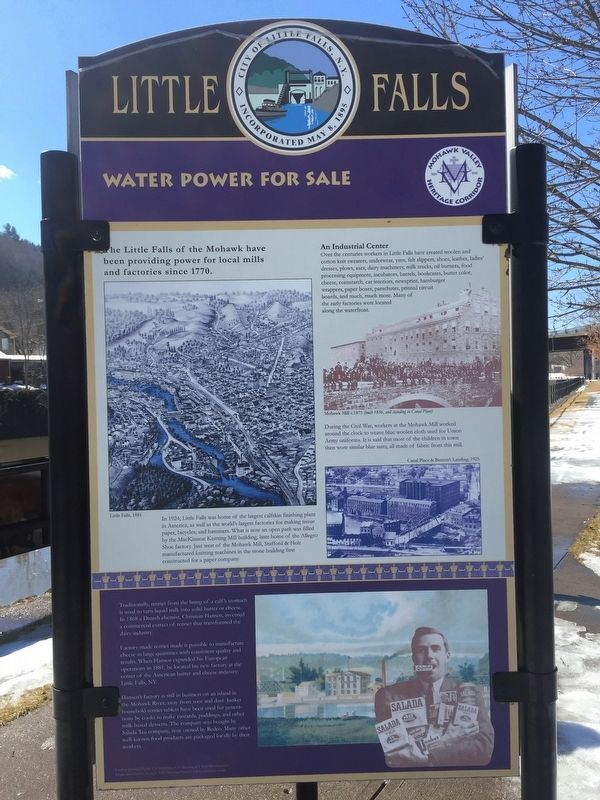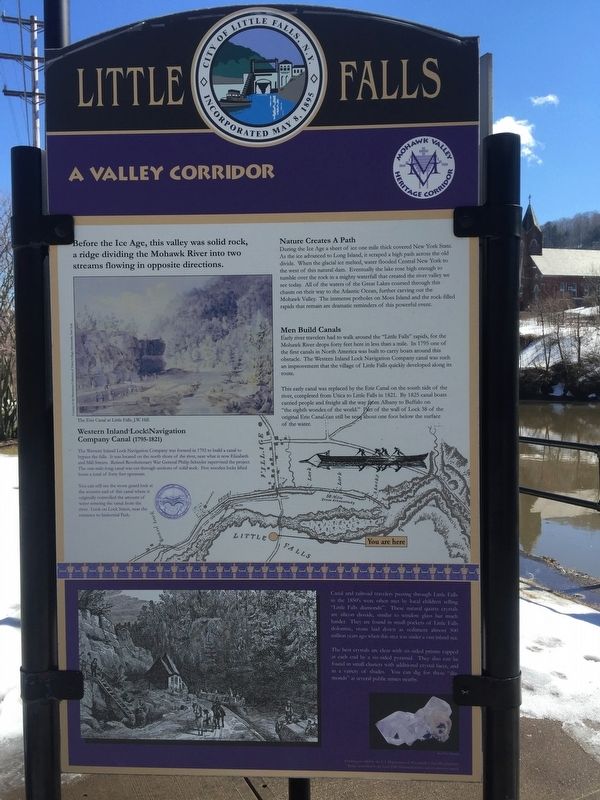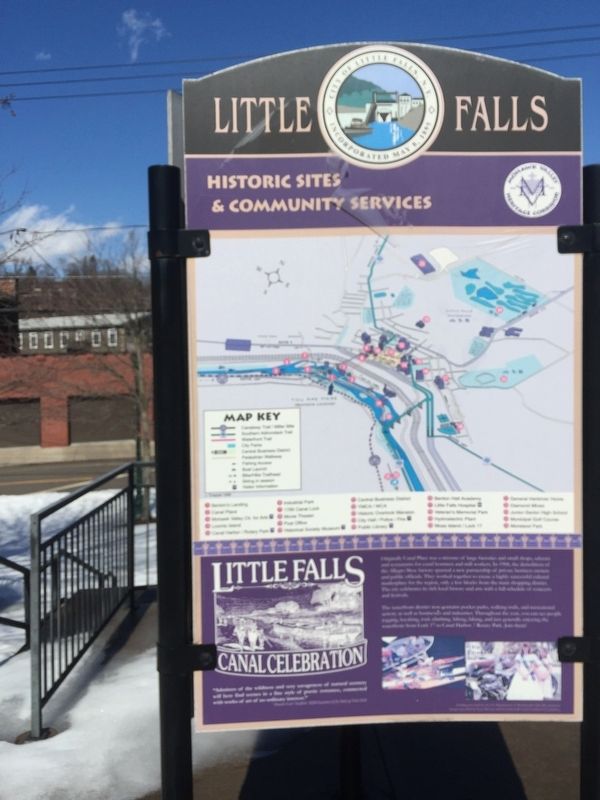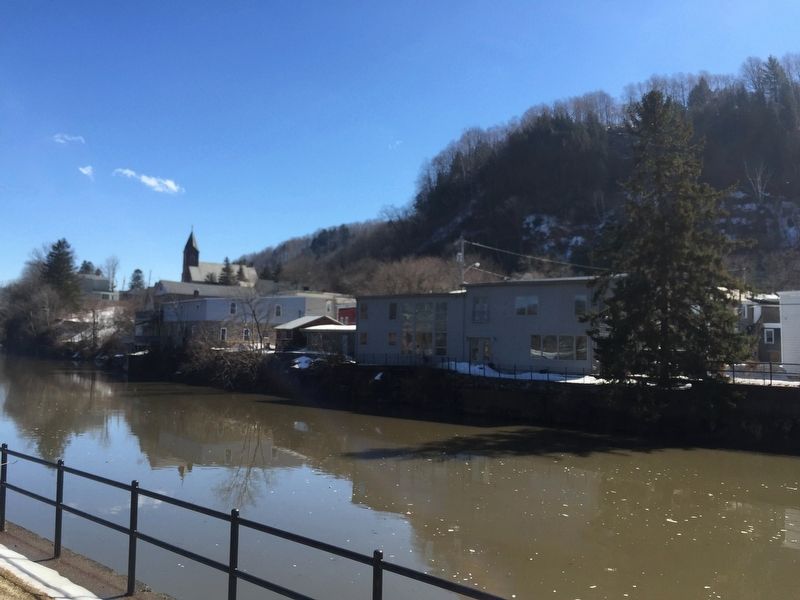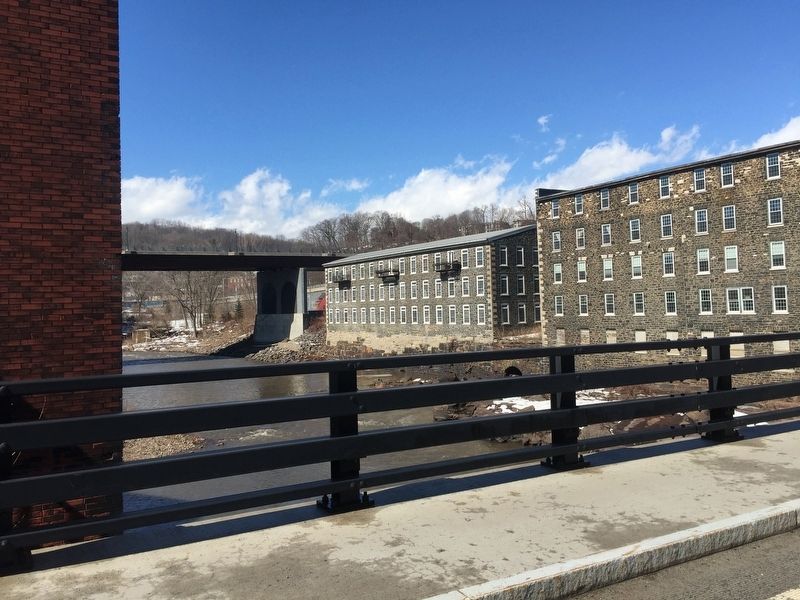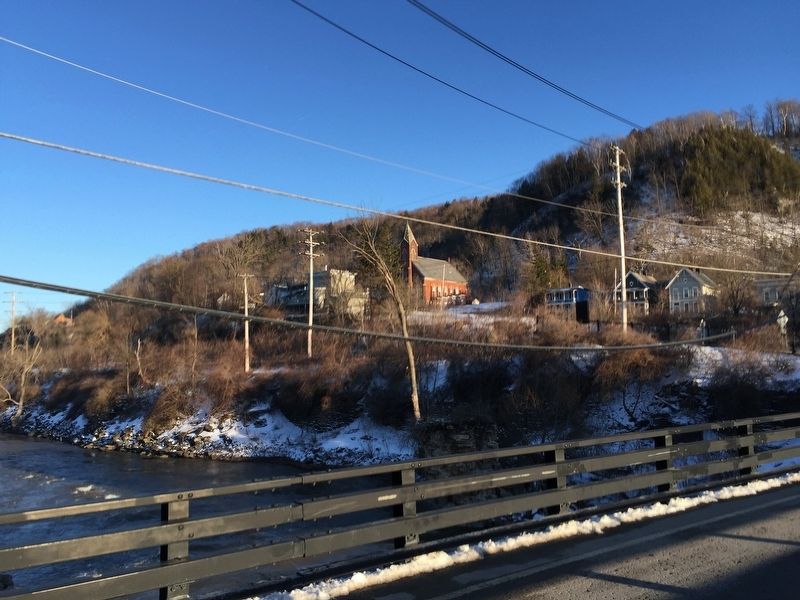Little Falls in Herkimer County, New York — The American Northeast (Mid-Atlantic)
Little Falls
Water Power for Sale/A Valley Corridor/Historic Sites and Community Services
Water Power for Sale
The Little Falls of the Mohawk have been providing power for local mills and factories since 1770.
An Industrial Center
Over the centuries workers in Little Falls have created woolen and cotton knit sweaters, underwear, yarn, felt slippers, shoes, leather, ladies dresses, plows, axes, dairy machinery, milk trucks, oil burners, food processing equipment, incubators, barrels, bookcases, butter color, cheese, cornstarch, car interiors, newsprint, hamburger wrappers, paper boxes, parachutes, printed circuit boards, and much, much more. Many of the early factories were located along the water front.
During the Civil War, workers at the Mohawk Mill worked around the clock to weave blue woolen cloth for Union Army uniforms. It is said that most of the children in town then wore similar blue suits, all made of fabric from this mill.
In 1924, Little Falls was home of the largest calfskin finishing plant in America, as well as the world’s largest factories for making tissue paper, bicycles, and hammers. What is now an open park was filled by the MacKinnon Knitting building, later home of the Allegro Shoe factory. Just west of the Mohawk Mill, Stafford and Holt manufactured knitting machines in the stone building first constructed for a paper company.
Bottom Inset
Traditionally, rennet from the lining of a calf’s stomach is used to turn liquid milk into solid butter or cheese. In 1868 a Danish chemist, Christian Hansen, invented a commercial extract of rennet that transformed the dairy industry.
Factory-made rennet made it possible to manufacture cheese in large quantities with consistent quality and results. When Hansen expanded his European operations in 1881, he located his new factory at the center of the American butter and cheese industry: Little Falls, NY.
Hansen’s factory is still in business on an island in the Mohawk River, away from the soot and dust. Junket household rennet tablets have been used for generations by cooks to make custards, puddings, and other milk-based desserts. The company was bought by Salada Tea company, now owned by Redco. Many other well-known food products are packaged locally by their workers.
A Valley Corridor
Before the Ice Age, this valley was solid rock, a ridge dividing the Mohawk river into two streams flowing in opposite directions.
Nature creates a path
During the Ice Age a sheet of ice one mile thick covered New York State. As the ice advanced to Long Island, it scraped a high path across the old divide. When the glacial ice melted, water flooded Central New York to the west of this natural dam. Eventually, the lake rose high enough to tumble over the rock in a mighty waterfall that created the river valley we see today. All the waters of the Great Lakes coursed through this chasm on their way to the Atlantic Ocean, further curving the Mohawk Valley. The immense potholes on Moss Island and the rock-filled rapids that remain are dramatic reminders of this powerful event.
Men Build Canals
Early river travelers had to walk around the “little Falls” rapids, for the Mohawk River drops forty feet here in less than a mile. In 1795 one of the first canals in North America was built to carry boats around this obstacle. The Western Island Lock Navigation Company canal was such an improvement that the village of Little Falls quickly developed along its route.
This earlier canal was replaced by the Erie Canal on the south side of the river, completed from Utica to Little Falls in 1821. By 1825, canal boats carried people and freight all the way from Albany to Buffalo on “the eighth wonder of the world.” Part of the wall of Lock 38 on the original Erie Canal can still be seen about one foot below the surface of the water.
Western Inland Lock Navigation Company (1795-1821) The Western Inland Lock Navigation Company was formed in 1792 to build a canal to bypass the falls. It was located on the north shore of the river, near what is now Elizabeth and Mill Streets. Retired Revolutionary War General Phillip Schuyler supervised the project. The one-mile long canal was cut through sections of solid rock. Five wooden locks lifted the boats a total of forty feet upstream.
You can still see the stone guard lock at the western end of this canal where it originally controlled the amount of water entering the canal from the river. Look on Lock Street, near the entrance to Industrial Park.
Bottom Inset:
Canal and railroad travelers passing through Little Falls in the 1850’s were often met by local children selling “Little Falls diamonds”. These natural quartz crystals are silicon dioxide, similar to window glass but much harder. They are found in small pockets of Little Falls dolomite, stone laid down as sediment almost 500 million years ago when this area was under a vast inland sea.
The best crystal are clear with six-sided prisms capped at each end by a six-sided pyramid. They also can be found in small cluster with additional crystal faces, and in a variety of shades. You can dig for these “diamonds” at several public mines nearby.
Historic Sites and Community Services
Little Falls Canal Celebration
“Admirers of the wilderness and very savageness of natural scenery will here find scenes in a fine style of poetic romance, connected with works of art of no ordinary interest.”
Horatio Gates Spafford, “1824 Gazetteer of the State of New York”
Originally, Canal Place was a mixture of large factories and small shops, houses, saloons and restaurants for canal boatmen and mill workers. In 1988, the demolition of the Allegro Shoe Factory spurred a new partnership of private business owners and public officials. They worked together to create a highly successful cultural marketplace for the region only a few blocks away from the main shopping district. The city celebrates its rich local history and arts with a full schedule of concerts and festivals.
The waterfront district now contains pocket parks, walking trails, and recreational activity as well as businesses and industries. Throughout the year, you can see people jogging, kayaking, rock climbing, hiking, biking, and just generally enjoying the waterfront from Lock 17 to Canal Harbor/Rotary Park. Join them!
Erected by US Department of Housing and Urban Development.
Topics and series. This historical marker is listed in these topic lists: Settlements & Settlers • Waterways & Vessels. In addition, it is included in the Erie Canal series list. A significant historical year for this entry is 1795.
Location. 43° 2.375′ N, 74° 51.536′ W. Marker is in Little Falls, New York, in Herkimer County. Marker is at the intersection of MoHawk Street and South Ann Street, on the right when traveling east on MoHawk Street. At Canal Place and Lock 17. Touch for map. Marker is in this post office area: Little Falls NY 13365, United States of America. Touch for directions.
Other nearby markers. At least 8 other markers are within walking distance of this marker. Benton’s Landing (a few steps from this marker); Lafayette's Tour (a few steps from this marker); A Bridge for Boats (within shouting distance of this marker); Route of the Little Falls Canal (about 500 feet away, measured in a direct line); The Cheese Business (approx. 0.2 miles away); The World's Best Cheddar (approx. 0.2 miles away); The Street Cheese Market (approx. ¼ mile away); Shaping the City (approx. ¼ mile away). Touch for a list and map of all markers in Little Falls.
Regarding Little Falls. This is a three sided marker
Credits. This page was last revised on March 25, 2019. It was originally submitted on March 23, 2019, by Steve Stoessel of Niskayuna, New York. This page has been viewed 443 times since then and 36 times this year. Photos: 1, 2, 3, 4, 5, 6. submitted on March 23, 2019, by Steve Stoessel of Niskayuna, New York. • Bill Pfingsten was the editor who published this page.
